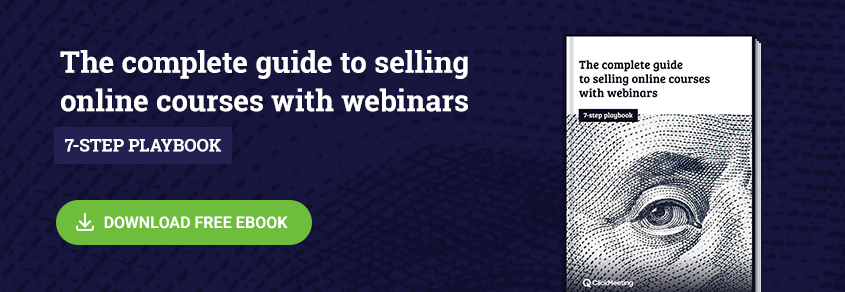From sharing valuable ideas and knowledge, through teaching and training online, up to selling products and services. Webinars have become a powerful multipurpose digital business tool. Before you take a deep dive into the “webinar ocean”, let’s take a closer look at the fundamentals and discover what is meant by a webinar. To put it simply – what is a webinar?
Quoting after the latest State of Webinars 2020 Report, we are talking about 627,033 webinars organized in 2019, on ClickMeeting platform alone! Those online events have gathered a total audience of 8,504,770 unique attendees all around the world.
Where is this phenomenon coming from? Let’s take the definition under the microscope.
Table of Contents
What is a webinar?
To cut to the chase, a webinar is a video conferencing and video marketing tool designed to deliver content more engagingly, in real-time.
Although the term itself implies the “seminar run on the web” meaning, there’s so much more to it! Webinars, packed with multimedia and plethora of interactive features, take business communication to another level.
Armed with webinar features like screen sharing, whiteboard with drawing tools, presentation, survey, or chat, you can unlock new possibilities to share (or sell) your knowledge and expertise during timely-scheduled, super-organized online sessions.
Here’s a fantastic example of a webinar. Watch how Owen Video hosted his online event for ClickMeeting:
The fact of meeting your audience online in one virtual conference room is a win-win situation for you and your attendees. You can reach your audience scattered all around the world and anyone interested in what you have to say can get easy access to it. Regardless whether they live on another continent or just around the corner.
That’s why webinars are winning business solutions. Rajmund Dziemaszkiewicz, the Product Owner at ClickMeeting, explains why:
In my opinion, there is no better way than webinars to effectively share your knowledge with large groups of people, regardless of where they are. Knowledge sharing is now a must-do for every business, and empowering leads with relevant content brings them closer to your brand.
However, according to Rajmund Dziemaszkiewicz, the potential of webinars reaches even further:
Many start-ups bring their MVPs to life and start to test their business assumptions on a local market. They do that locally to reduce the costs they would spend on going worldwide. To evaluate their product, they don’t have to limit themselves! With webinars, they can scale up their actions and ship their MVPs globally, get meaningful insights from their prospects and leads located in different parts of the planet, and eventually convert that feedback into tweaking their product.
What are the types of webinars?
Yes, it’s getting more exciting! You can differentiate webinars by:
- the purpose;
- the event types;
- the access types.
The purpose:
Let’s begin with defining webinars when it comes to their purpose. Depending on what you want to achieve businesswise, you can take leverage on these types of webinars:
-
Knowledge-sharing lead generation webinars. If you are a digital marketer, this should be your weapon of choice. That sort of online events aims to share your valuable and relevant expertise with your prospects and leads. Thanks to giving away your significant insights, you have a chance to create a long-lasting relationship with your leads, and eventually convert them into customers.
These webinars are content marketing at its finest and serve as a remarkable tool to establish your position as an expert in your niche.
When you think lead gen, you consider various activities to maintain high quality and convert the leads. The risk is always the same: you perform costly actions and, as a result, you generate many leads that won’t convert into paying customers. Webinars, as a lead generating tool, are a very effective way to build your customer base effectively. You share your knowledge and record your presentation that you can publish as a content available on-demand to whoever drops their contact detail. As a final result, you produce content that can be a very powerful tool to generate a high-quality database that you can nurture with further content adjusted to your audience’s preferences – says Agnes Józwiak, Senior Product Marketing Manager at Spartez Software.
-
Product demo webinars. Demonstrating your product online comes in line with webinars. Taking into consideration that 94% video marketers say that video has helped users in understanding their product or service, and the fact that 79% of interviewees admitted that watching a video has convinced them to buy a product, webinars are one of the most important online sales tools in the digital landscape.
Let the numbers do the talking:



Another striking aspect of product demo webinars is that they work exceptionally well for the B2B sector. Decision-making process (when it comes to buying business services) is longer and more complex than in the B2C reality.
In contrast to a B2C fast-media consumption, webinars provide a chance to take a deep-dive into a product, and that is often a decision-trigger for C-level managers in larger companies and business owners in the SMB sector.

Let’s see how ClickMeeting’s Brand Manager, Tomasz Bołcun, regards product demo webinars:
The more complicated your offer is, the harder becomes the final buying decision. If your leads find your product difficult, the chances of converting them into clients grow thin. You may find it frustrating that despite all your self-education resources, your leads stop somewhere in the customer journey and decide to bounce. For me, running a live product demo with a webinar is a remedy here because a salesperson can answer all the questions in real-time, clear doubts or even bust myths if any of them pop-up during an event. Product demo webinars are also a great opportunity to entice leads with some special deals offered only for webinar attendees. They have all the features it takes to make your offer super-attractive and unique.
-
Online courses. Over the last few years, e-learning has grown to a thriving industry, giving tremendous opportunities to sell knowledge to students and professionals around the world.
Webinars are a dream tool to monetize your know-how and expertise, especially when you integrate your webinar account with services like PayPal and Moodle.
Imagine a virtual classroom equipped with all the tools you need to have to deliver your knowledge efficiently and engagingly: presentation, video, whiteboard with drawing tools, chat and Q&A, polls, and surveys (just to name a few).
If you are interested in selling your online courses with webinars, we have a real treat for you:
Here’s what Arturo Tedeschi, the world-class computational designer, says about running online courses with webinars:
Thanks to webinars, I can reach a hundred or two hundred people at the same time. It’s about starting a new kind of relationships with people. You can talk with much more people and create a new form of dialogue with this form of communication.
Let’s get back to our Product Owner, Rajmund Dziemaszkiewicz:
The online education sector is in its renaissance phase right now. From solopreneurs teaching online, through small and medium training companies, up to renowned educational institutions – they are all embedding webinars into their offer. What’s more, universities are more likely to run entire courses with webinars. Thanks to this technology, they can reach more students than ever before.
-
Onboarding and training sessions. This is where medium and large companies benefit from webinars and video conferencing the most. With branches located around the region, the country or the continent, there’s no other way to conduct onboarding or training sessions of the new employees, and then going online with the entire process.
Organizing webinars for training purposes saves time, effort, and money that enterprises used to spend on traditional offline training sessions. Instead of burning resources on business travels or hiring venues, you can run it all in one virtual conference room.
Take a look at Nest Bank’s experience:
Today, if we had to come back to stationary training events, we would have to organize 16 large sessions in 16 different regions. It would take ten times longer to achieve it, not even mentioning the travel costs, venues, accommodations, and so on – says Krzysztof Grodecki from Nest Bank. – Instead of wasting two weeks of our time, we spend only one day to do this all with a single webinar!
The event types
OK, as soon as you know your purpose, it’s time to analyze the types of webinars you can organize to achieve your business goals.
We distinguish three types of events:
1) Live webinars. A classic and most popular version of webinars. You schedule your online event to happen at a specific time, and then you meet your audience live.
The main advantage here is about real-time interaction with your webinar attendees. It gives you a chance to make the most of two-way communication via a chat window. It also allows you to receive instant feedback, especially when you explain a complex topic, and you need to make sure that everything you said is clear to everyone.
Live webinars are an ideal match with:
- Onboarding and training purposes because you can evaluate how your trainees absorb your insights as you move along.
- Sales and product demos as they open an opportunity to maximize your impact on your audience and influence them to make a final purchase decision.
The problem with live webinars is that not all of your registrants show up at the live event. It has nothing to do with the quality of your offer. On the contrary – it has everything to do with the lack of time we’re all facing in today’s crazy world.
Don’t give up on the people who didn’t join your event. There are two compelling ways to reach them with your content.
First, you send them the recording of your webinar.
Second, you go for:
2) On-Demand Webinars. In this option, you can anticipate that your audience is utterly busy, and pre-record your webinar to release it to your contacts, leads, or students so they can watch it anytime and anywhere they want.
This way, you’re letting yourself go from being present at each webinar as a presenter, and let your audience watch and listen to your presentation whenever it suits them. It’s a win-win situation!
Watch this video to learn how to create an On-Demand Webinar:
On-Demand Webinars will do the trick for all purposes, but if you aim at generating leads with your content and running online courses, you should certainly employ them to your webinar tactic plan. Releasing several on-demand events to the digital stratosphere will save you the time you would spend on hosting numerous live events.
3) Automated Webinars. Yes, automation is a buzzword nowadays. Why? Because we’re all going around the clock to achieve our business results and automation takes the repetitive and mundane work off our shoulders.
Unlike on-demand events, you schedule Automated Webinars to take place at a specific day and hour (in what it resembles live webinars). However, just like in on-demands, you need to record your webinar first, and then compose it with some additional video materials, a survey, and a custom Call-To-Action button.
Here’s how to do it in real life:
The automation does the rest for you. Imagine creating twenty lessons of your online course as automated webinars. They will gather your students at a particular time, but you won’t have to be in the webinar room physically to host the entire thing.
The access types
It’s the last aspect of distinguishing types of webinars. As the above title suggests, it’s all about the way you want your attendees to access your online event.
Here, you need to choose from:
- Open to all events. This option gives your attendees a chance to join your webinar for free. Works great if you want to inspire and share knowledge to enhance your brand awareness and generate leads.
- Token- or password-protected events. It’s an excellent choice if you don’t want to go public with your content and limit it with passwords or tokens. That goes to companies internal training events with sensible data or sharing specific knowledge only with your sales qualified leads or customers.
- Paid webinars. Remember the part about monetizing your expertise? Here’s how! By choosing a paid event access type, you set an entrance fee to your webinar and make money on your valuable content.
Bear in mind, that you can create Live, On-Demand, and Automated Webinars as paid events.
What is the webinar software? How does it work?
Okay, now you are fully aware of why to go for webinars and what types of online events you can run to achieve your business goals.
But to do that all, you will need a tool. Webinar software is an application designed and developed to keep all your video conferencing and webinar activity under one roof.
It’s a platform where you create your webinar account, and manage all your online events – from integrating with useful tools like Google Analytics, PayPal, HubSpot, Slack (and much more), scheduling your Live, On-Demand, and Automated Webinars, inviting your audience and sharing your content on social media, up to exporting contacts to your CRM, and analyzing your webinar efforts.
ClickMeeting is a browser-based webinar software which means you don’t need to install anything on your device to run webinars and your video conferencing actions are secure.
Instead of a summary – webinar cycle method
In terms of delivering sales and marketing results, webinars have been regarded as a video content marketing format that fits into each stage of the sales funnel.
But webinars have grown to be a stand-alone business, and there is much more to achieve with them than within a traditional, linear funnel.
That’s why, in ClickMeeting, we have come up with an alternative concept for webinars which no longer leaves you with the plethora of features and integrations. Instead of telling you “hey, there you go – it’s a platform with plenty of tools and ingredients, now feel free to deal with it”, we have come up with a different approach.
And that’s building use case scenarios and cycles to achieve growth with webinars.
We called it webinar cycle, which is a step-by-step blueprint bringing together features, integrations, and automation. Starting up with webinars is now easier than ever. Are you ready?




 (16 votes, average: 4.75 out of 5)
(16 votes, average: 4.75 out of 5)




